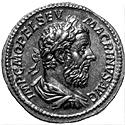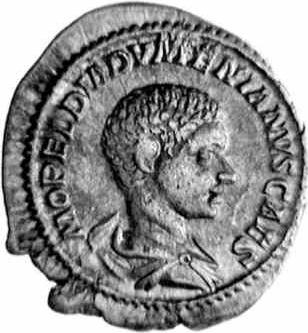Roman Emperors Dir Macrinus
An Online Encyclopedia of Roman Emperors
Macrinus and Diadumenianius(217-218 A.D.)
Michael L. Meckler
 Macrinus
Macrinus Diadumenianus
Diadumenianus
Macrinus was born in Caesarea in Mauretania around the year 165. While it is highly conjectural that, as a young man, the future emperor was the dedicatee of Ampelius' encyclopedic Liber memoralis, Macrinus undoubtedly received a literary education that enabled him to rise high as a bureaucrat in the imperial service during the reign of the emperor Severus. Caracalla made Macrinus a praetorian prefect, an equestrian post that was second to the emperor in power. Macrinus shared the position with the experienced soldier Adventus, and the pair served Caracalla during the emperor's campaigns in the East.
By the end of the second campaigning season in the winter of 216-17, rumors were flying both in Rome and in the East that Macrinus was promoting himself as a possible future emperor. Caracalla must have been aware of the rumors concerning Macrinus, for the contemporary historian Cassius Dio notes the emperor was already reassigning members of Macrinus' staff. Such personnel moves may have accelerated Macrinus' plot.
Shortly before the campaigning season was to begin, Caracalla paid a visit to a temple near Carrhae. The emperor was accompanied by a hand-picked corps of bodyguards. The guards returned with Caracalla's murdered body along with the body of one of the guards and a story that the dead guard killed the dead emperor. Not everyone was convinced, but Macrinus was able to translate his authority as praetorian prefect into that of emperor, being proclaimed by the troops on 11 April 217. Macrinus soon named his son, Diadumenianus, as Caesar and heir. The new emperor also got his former colleague, Adventus, out of the way by sending him back to Rome as urban prefect.
Macrinus straightaway sent conciliatory messages to the Parthian ruler Artabanus V, but Artabanus sensed weakness and raised an army to avenge his losses from the previous year's campaign. Macrinus hoped to avoid a battle with the Parthians, but fighting erupted between the armies while both sides were encamped around Nisibis. The Parthians gained victory and, during the following autumn and winter, peace negotiations were held. Macrinus ended up paying the Parthians large bribes and reparations. Settlements were also reached with the Armenians, and, in the lower Danube, with the Dacians, who had launched attacks on the Romans after learning of Caracalla's death.
By not returning to Rome in 217, Macrinus opened himself to criticism. Dissatisfaction was especially high in the city after a particularly violent, late-August thunderstorm started a fire that damaged much of the Colosseum and caused widespread flooding, especially in the Forum. Adventus proved himself incompetent as urban prefect and had to be replaced.
But grumblings in Rome were insignificant compared to the growing unease among the soldiers on campaign in the East. The defeat at Nisibis disheartened troops. Macrinus also introduced an unpopular, two-tier pay system in which new recruits received less money than veterans. The move was a way to save money after the pay raise granted by Caracalla, but it lowered morale as well.
Earlier, Caracalla's mother, Julia Domna, had toyed with the idea of raising a rebellion against Macrinus shortly after her son's murder, but the empress was uncertain of success and already suffering from breast cancer. She chose to starve herself to death instead.
The grandchildren of her sister, Julia Maesa, would become the focus of the successful uprising that began on 15 May 218. Her 14-year-old grandson Avitus (known to history as Elagabalus) was proclaimed emperor by one the legions camped near the family's hometown of Emesa. Other troops quickly joined the rebellion, but Macrinus marshalled loyal soldiers to crush the revolt. Macrinus also promoted his son to the rank of emperor.
The forces met in a village outside Antioch on 8 June 218. Despite the inexperience of the leaders of the rebel army, Macrinus was defeated. He sent his son, Diadumenianus, with an ambassador to the Parthian king, while Macrinus himself prepared to flee to Rome. Macrinus traveled across Asia Minor disguised as a courier and nearly made it to Europe, but he was captured in Chalcedon. Macrinus was transported to Cappadocia, where he was executed. Diadumenianus had also been captured (at Zeugma) and was similarly put to death.
Contemporaries tended to portray Macrinus as a fear-driven parvenu who was able to make himself emperor but was incapable of the leadership required by the job. An able administrator, Macrinus lacked the aristocratic connections and personal bravado that might have won him legitimacy. His short reign represented a brief interlude of Parthian success during what would prove the final decade of the Parthian empire.
PRIMARY SOURCES
Cassius Dio, Roman history, book 78 (available in English translation in the Loeb Classical Library)Herodian, books 4-5 (also available in the Loeb Classical Library)
Historia Augusta, Life of Macrinus (highly untrustworthy; English translations available in the Loeb Classical Library and in a Penguin translation, Lives of Later Caesars, tr. Anthony Birley
RECENT BIBLIOGRAPHY:
Drora Baharal, Emperor Macrinus: imperial propaganda and the Gens Aurelia (diss. Tel Aviv Univ., 1996)
André Chastagnol, Histoire Auguste (Paris: Robert Laffont, 1994), pp.443-49
Fergus Millar, The Roman Near East (Cambridge, Mass.: Harvard, 1993), pp.144-46
Robert Turcan, Histoire Auguste, t.III,1, Vies de Macrin, Diadumenien, Heliogabale (Paris: Les Belles Lettres [Budé], 1993)
For more detailed geographical information, please use the DIR/ORBAntique and Medieval Atlas below. Click on the appropriate part of the map below to access large area maps.
 DIR Atlas
DIR Atlas